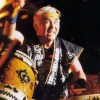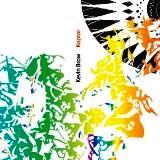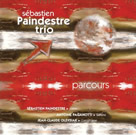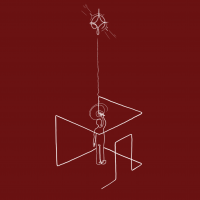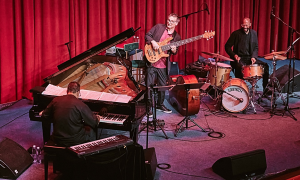Home » Jazz Articles » Profile » Daihachi Oguchi: Taiko Drum Master Silenced
Daihachi Oguchi: Taiko Drum Master Silenced
Your heart is a taiko. All people listen to a taiko rhythm, dontsuku-dontsuku in their mother's womb. It's instinct to be drawn to taiko drumming.
—Daihachi Oguchi
 A former jazz drummer, Daihachi Oguchi took ancient rhythms, broke them down and created new arrangements and compositions to accommodate an ensemble of drummers. He helped turn the traditional form into a dramatic performance spectacle. Elevating the traditional folk sounds of taiko to modern music played in concert halls, not just festivals and shrines. He led and starred in the performance of drumming and dance at the closing ceremony of the 1998 Nagano Olympics.
A former jazz drummer, Daihachi Oguchi took ancient rhythms, broke them down and created new arrangements and compositions to accommodate an ensemble of drummers. He helped turn the traditional form into a dramatic performance spectacle. Elevating the traditional folk sounds of taiko to modern music played in concert halls, not just festivals and shrines. He led and starred in the performance of drumming and dance at the closing ceremony of the 1998 Nagano Olympics. Taiko is a powerful cultural asset in Japan. It is an ancient form, yet a new invention. In many regions festivals are celebrated throughout the year based on seasonal changes. People enjoy these festivals for they provide an escape from the daily obligations they must endure. These festivals also draw people together. The community helps to make the festival a success, and each person is valued as an important member of the community. The new style—Taiko Ensemble—created by Daihachi Oguchi, provides a means for large numbers of people to participate in taiko performances.
Along with Kabuki theater and "ukiyoe" woodblock prints, taiko is one of Japan's most popular—and respected—art forms in the West. Part dance and part athletics, modern taiko can be dazzlingly visual and acrobatically physical. Taiko, especially the big ones that tower over the drummers, make dramatic booming sounds. A taiko drum is made from a single hollowed out tree trunk with cowhide strapped tightly across it. Thanks partly to Oguchi and his followers' efforts, hundreds of taiko groups, both professional and amateur, have sprung up not only throughout Japan but also in the U.S., Brazil, Europe and other nations. Oguchi also was one of the first composers of modern taiko, writing catchy tunes based on historical themes, such as samurai storming on horses, and helping make taiko a household word in Japan.
Oguchi helped found top U.S. taiko groups, including San Francisco Taiko Dojo, which has performed in Hollywood movies and on international tours since its founding 40 years ago. His film work includes Deep Rising (1998), "Amano-Naru-Tatsuo Dai-Kagura" (arranger), and Step Across the Border (1990) (musician). But his influence on today's film soundtracks goes well beyond.

The advent of Lucas Films THX sound system and the wrap around sound has heightened the theater going experience. Following, special effects and omnipresent chase scenes are part in parcel integrated into films.
All which has the effect on the soundtracks with increasing expansion of the percussion section in the orchestra. With bigger and better, wilder chase scenes each out doing that last, with wilder and louder musical scores. The heavy bottom bass frequency being moved deeper to match. When once the back percussion section of the orchestra you'd find typically several tympani, now Oguchi's influence you most often find rows of various and large taiko drums filling the ever expanding percussion ranks.
Big Fat Drum Origins
Taiko, a word that in Japanese means simply "Big" or "Fat Drum," is a musical form firmly associated with Japanese cultural heritage; for some it is considered the heartbeat of Japan. Its origins are uncertain but it is known that it dates back as far 600 A.D. and was originally brought to Japan with the introduction of Buddhism. In Japan the taiko drums have been used in a variety of settings: agrarian, sacred, military, theater, and the royal court. During the 1970s, taiko drumming saw a resurgence as the Japanese government allocated funds to preserve Japanese culture. 
Japanese immigrants had brought taiko to North America in the early 1900s and its growth in popularity was spearheaded in the early 1960s and 1970s primarily by master taikoists in San Francisco, Los Angeles, and San Diego. Today it is estimated there are as many as 8000 taiko groups in Japan, 1000 groups in North America, and hundreds more around the world. Weeklong festivals attract thousands, it is taught in taiko schools and university programs, and there is even a video game Taiko Drum Master.
Taiko is usually performed today as an ensemble, including an array of shapes and sizes of drums. Gongs of various size and shape add musical depth, a bamboo flute occasionally offers a melody, and vocals provide additional punctuation and texture. Typically each performer carries a particular rhythm on one or more drums; together the musicians rotate around the drums in very athletic, highly choreographed arrangements. It is no wonder that many contemporary taiko performers are also dancers and athletes.
Oguchi was a student during the war, and was drafted and sent to China where he was taken prisoner. Returning home to Suwa City in 1947, two years after Japan's surrender, acting on his love of jazz he formed a local band in which he was the drummer. A few years later, a relative found an old document in a soybean warehouse, and believing it to be a musical score for taiko, brought it to Oguchi who he hoped would use his drumming knowledge to decipher it. With the help of town elders, the circles and check marks were determined to stand for various taiko beats and the taiko score was revealed. Oguchi, having a passion for drums and music, but no experience with taiko, wanted to perform the old deciphered music for the Osuwa Shrine. Visiting antique stores and borrowing old drums, he began to build up a collection of drums and a group to play them. After hearing the piece played in its authentic form. Oguchi used his jazz drumming experience to make what he found to be a monotonous piece into something more interesting.
Oguchi, having a passion for drums and music, but no experience with taiko, wanted to perform the old deciphered music for the Osuwa Shrine. Visiting antique stores and borrowing old drums, he began to build up a collection of drums and a group to play them. After hearing the piece played in its authentic form. Oguchi used his jazz drumming experience to make what he found to be a monotonous piece into something more interesting.
In general, post-WWII times caused stylistic changes in music as a whole, making it more daring and extroverted and opened up room for experimentation. Japan's culture fuses its old political, social, and artistic practices with modern-day trends of the Western world. Oguchi began to jazz up taiko. With his drumming background, he wondered why taiko was not played in groups as an ensemble. Oguchi added new rhythms and divided up the rhythms into multiple, simple patterns.
He took taiko of various sizes, and assigned specific roles to each musical voice. Some players parts even involved using several taiko at once arranged in the style of a jazz set. The odaiko played a simple grounding pulse, the high-pitched 'shime' carried the 'ji' (background rhythm), and a variety of nagado-daiko played the melodic parts.
When the drums available to him were no longer suitable, as they were drums meant for use in festivals and not as performing instruments, he began to create his own drums, and auxiliary instruments as well, to better fit his needs. One of his distinguishing creations was adding the metallic sound of the bell-like tetsu- zutsu, to top off his ensemble. This ensemble-type playing enabled Oguchi to increase the musical complexity of his pieces exponentially and at the same time, it provided a means for large numbers of people to participate with relative ease. By 1951, Oguchi had established his own ensemble group, Osuwa-Daiko, and the beginning of this new age of kumi-daiko had begun.
Charming, fiery and vivacious, although he was in failing health in recent years, Oguchi, at the age of 84 had been scheduled to perform with Kodo, a well-known taiko group. On a Thursday the end of June, while crossing the street, a car struck Oguchi. He was rushed to the hospital but later died of excessive bleeding early Friday June 27th, said Yuken Yagasaki, a member of the master musician's Nagano-based ensemble, Osuwa Daiko.
While taiko in North America has become a rich and varied form of drumming, as idiomatic as jazz or American Indian forms, it nonetheless continues to be an important component of Japanese identity and culture.
In taiko, man becomes the sound.
In taiko, you can hear the sound through your skin.
 Daihachi Oguchi 1924 ~ 2008
Daihachi Oguchi 1924 ~ 2008
Tags
PREVIOUS / NEXT
Support All About Jazz
 All About Jazz has been a pillar of jazz since 1995, championing it as an art form and, more importantly, supporting the musicians who make it. Our enduring commitment has made "AAJ" one of the most culturally important websites of its kind, read by hundreds of thousands of fans, musicians and industry figures every month.
All About Jazz has been a pillar of jazz since 1995, championing it as an art form and, more importantly, supporting the musicians who make it. Our enduring commitment has made "AAJ" one of the most culturally important websites of its kind, read by hundreds of thousands of fans, musicians and industry figures every month.


